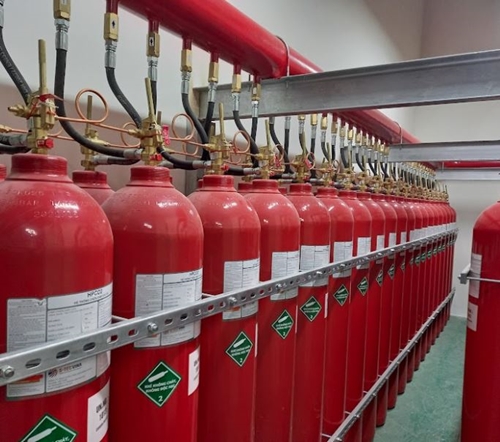CO2 FIRE SUPPRESSION SYSTEM
In today advanced world, fire safety is paramount, especially in environments where valuable assets or sensitive operations are at stake. Carbon dioxide (CO2) fire suppression systems are highly effective for extinguishing fires in closed and unoccupied spaces, making them a preferred choice for many industries. S-TEC VINA proudly offers state-of-the-art CO2 fire suppression systems. Let take a closer look at their structure, operation, and key features.
1. General Information and Operating Principles
• Fire Extinguishing Agent: CO2
• Capacity: 68L/45kg CO2
• Components:
- Tank with head valve and safety pressure release valve
- Optional power meter
• Operating Principle: When a fire is detected, the system releases CO2 to reduce oxygen levels below 14%. The CO2 cools the fire by absorbing heat as it evaporates and dilutes flammable vapors (around -78.9 degrees Celsius), effectively extinguishing the fire.
CO2 fire suppression system
2. Inspection and Maintenance
Every 6 Months:
According to ISO/TCVN standards, the following inspection and maintenance procedures must be implemented as outlined. These procedures should also be carried out if any unusual event occurs that could impact the systems safety.
♦ Step 1: Weigh the tank again to determine the amount of gas inside.
♦ Step 2: Inspect all components, including the mounting bracket. Tighten, repair, or replace any parts as needed.
♦ Step 3: Replace any components if there are concerns about their ability to function properly.
♦ Step 4: Check all pipes, fittings, and exhaust nozzles for looseness, dirt, or damage. Ensure all outlet piping is clean and free of dirt, debris, plugs, or any other foreign materials that could prevent the system from discharging extinguishant effectively.
Annual Inspection:
The entire system must be inspected and tested for operation at least once a year, or more often if required by the competent authority, by personnel trained by the manufacturer.
♦ Containers: Containers should undergo periodic inspections as mandated by relevant national standards.
♦ Pipes: All system pipes must be inspected annually for damage. If visual inspection reveals any defects, the pipes must be replaced.
♦ Protected Areas: Rooms equipped with gas fire suppression systems should be checked at least once every 12 months. This inspection evaluates whether there have been any structural changes that could impact the containment of fire extinguishing gas or affect firefighting effectiveness. If visual inspection is insufficient for evaluation, regulatory guidelines require checking the rooms integrity.
3. Applications of CO2 Fire Suppression Systems
► Ideal for closed and unoccupied areas such as:
• Control rooms and data processing centers
• Transformer and power rooms
• Telecommunications equipment rooms and cable tunnels
• Flammable liquid storage and paint booths
• Medical facilities, libraries, museums, and art galleries
• Server rooms and explosives storage areas
4. S-TEC VINA - A reputable fire suppression system manufacturer nationwide
S-TEC VINA is a leading manufacturer of fire suppression systems across Vietnam. Our company aims to pioneer the production of gas automatic fire suppression systems in the country. Utilizing advanced Korean technology, S-TEC VINA takes pride in manufacturing clean gas fire suppression systems, including:
•
SNS-100: IG-100 (N2) Nitrogen Fire Suppression System
•
SFS-200: HFC-227EA (FM-200) Gas Fire Suppression System
•
HPCO2: CO2 Fire Suppression System
•
SMS-227/SMS-5112: Automatic Gas Fire Suppression System with HFC-227EA (FM-200)/FK-5-1-12 (NOVEC 1230)
•
SFS-1230: FK-5-1-12 (NOVEC 1230) Gas Fire Suppression System
At S-TEC VINA, we are dedicated to delivering high-quality service. Our team of skilled and experienced design consultants ensures that we provide optimal fire protection system solutions for projects nationwide.
Contact S-TEC VINA today for expert advice tailored to your needs!





